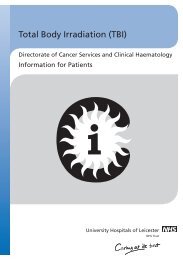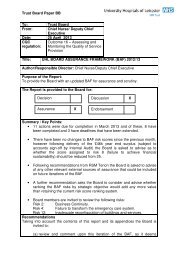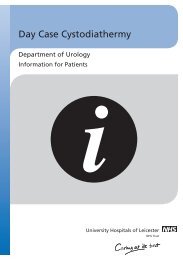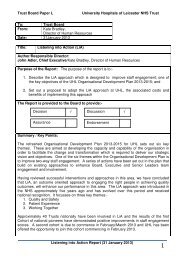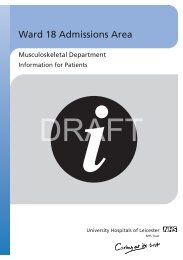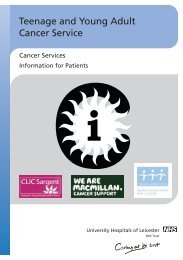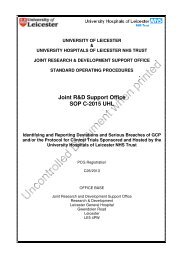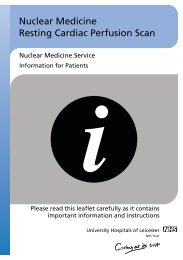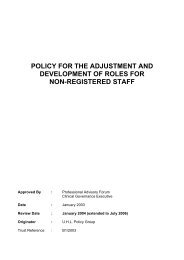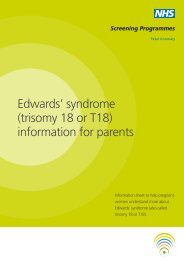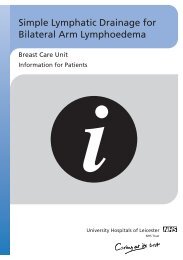Information Security Policy (UHL) - Library - University Hospitals of ...
Information Security Policy (UHL) - Library - University Hospitals of ...
Information Security Policy (UHL) - Library - University Hospitals of ...
Create successful ePaper yourself
Turn your PDF publications into a flip-book with our unique Google optimized e-Paper software.
INFORMATION SECURITY POLICYTrust ref: A10/2003Approved by:Trust BoardDate <strong>of</strong> approval: 9 October 2003Most recent review:<strong>Policy</strong> and Guideline Committee20 April 20096 October 2008Date <strong>of</strong> next review: April 2011Version number: 4Responsibility forReview:Gareth Lawrence,<strong>Information</strong>GovernanceManagerDave Rose,Technical <strong>Security</strong>SpecialistNB: this updated document also replaces the previous Trust guidelines on the removal <strong>of</strong>information from Trust premises (<strong>of</strong>f-site working), and the security <strong>of</strong> information processingequipment.Page 1 <strong>of</strong> 19
ContentsDocument change control .......................................................................................... 31. Introduction...................................................................................................... 41.1 This document ............................................................................................. 41.2 Purpose ....................................................................................................... 41.3 Failure to Comply......................................................................................... 41.4 Monitoring and Review ................................................................................ 52 <strong>Security</strong> Organisation.......................................................................................... 62.1 Roles and responsibilities ............................................................................ 62.2 Legal Obligations and Related Policies........................................................ 83. <strong>Policy</strong> Statements ............................................................................................... 84. <strong>Security</strong> <strong>of</strong> Assets ............................................................................................. 104.1. Desktop Devices ........................................................................................ 104.2. Physical security ........................................................................................ 114.2.1. <strong>Security</strong> <strong>of</strong> information ................................................................................ 114.2.2 <strong>Security</strong> <strong>of</strong> premises .................................................................................. 124.3. Servers ...................................................................................................... 124.4 Using removable media ............................................................................. 124.5 Medical/Laboratory Equipment...................................................................... 144.6. Disposal <strong>of</strong> equipment ................................................................................... 144.7 Shredding................................................................................................... 154.7.1 Fax rolls .............................................................................................. 155. Offsite working............................................................................................... 165.1 Physical <strong>Security</strong> / Access control ............................................................. 165.1.1 Usage in any public access area ........................................................ 165.1.2 Usage in areas not generally accessible to the public (including otherNHS premises).................................................................................................. 165.1.3 Occasional usage at home....................................................................... 165.1.4 Using equipment supplied by the Trust .................................................... 175.2 Email and <strong>of</strong>fsite working ........................................................................... 175.2.1 Patient Identifiable Data Contained in an email........................................ 175.2.2 Auto forwarding ........................................................................................ 175.3 Transport <strong>of</strong> Equipment, Files and Paper Documents ............................... 185.4 Disposal <strong>of</strong> media (electronic & paper) ...................................................... 185.5 Disaster Recovery/Major incident planning................................................ 186. Awareness <strong>of</strong> this policy.................................................................................... 187. Contacts............................................................................................................ 18Glossary <strong>of</strong> terms ..................................................................................................... 19Page 2 <strong>of</strong> 19
Document change controlDate Version Author ReasonMarch 09 4 Gareth LawrenceDave RoseAmalgamation <strong>of</strong> the security policywith the <strong>Security</strong> <strong>of</strong> <strong>Information</strong>Processing Equipment <strong>Policy</strong> andthe Removal <strong>of</strong> <strong>Information</strong> fromTrust Premises <strong>Policy</strong> (at the requestSeptember083 Gareth Lawrence,Dave Rose<strong>of</strong> the PGC), and revisions.Section 1.5 acknowledgment,removed.2. <strong>Security</strong> Organisation – revised.Additional policy statements 3.9,3.11-3.14 added to bring thedocument further into line with ISO27001. Statement 3.2 removed.Section 4 added.Amendment to 3.4 to refer todisaster recover plans (businesscontinuity being a directorateresponsibility).July 06 2 Rod Makosch Document revised for clarity andsimplicity.<strong>Policy</strong> backed up by guidancedocuments05/05 2 Gareth LawrenceRod MakoschMajor revision to the structure <strong>of</strong><strong>Policy</strong>, with the introduction <strong>of</strong> manysupporting procedures in place <strong>of</strong>policy Text.1. Removal <strong>of</strong> Section A and B.2. <strong>Policy</strong> statements are nowincluded in the main body <strong>of</strong>the text.16/10/03 1.7 Gareth Lawrence Amendment to section B.5.4Disposal <strong>of</strong> Equipment followingguidance from the DoH on datadestruction.9/10/03 1.6 Approved by Trust BoardSeptember 1.6 Gareth Lawrence Following discussion with Staff SiderepresentativesJuly 1.5` Gareth Lawrence Minor changesMay 03 1.4 Dave Rose, Gareth Lawrence Tailored for <strong>UHL</strong>March 03 0.3 Vicky Hill – Leicestershire Base DocumentsHealth Informatics ServiceChange Control: all requests for change to the <strong>Information</strong> Governance Mangerx6053Page 3 <strong>of</strong> 19
1. Introduction1.1 This documentThis document is the <strong>Information</strong> <strong>Security</strong> <strong>Policy</strong> <strong>of</strong> the <strong>University</strong> <strong>Hospitals</strong> <strong>of</strong>Leicester.The policy applies to all Trust business and covers the information, informationsystems, networks, physical environment, employees and contractors who supportthose business functions including where these facilities are shared with or ownedby external partners. The policy will be complied with in conjunction with otherapproved Trust policies and with other legal obligations <strong>of</strong> <strong>UHL</strong>.1.2 PurposeThe purpose <strong>of</strong> this policy is to ensure that information processing systems, andelectronic or paper based information, are protected from events that mayjeopardise staff and patients’ rights to confidentiality, other healthcare activities or,the business objectives <strong>of</strong> <strong>UHL</strong>.The rules, measures and procedures described herein determine the protection <strong>of</strong>the Trust’s assets by ensuring that:-• <strong>Information</strong> systems are properly assessed for security.• Availability is ensured (information is delivered to the right person, whenneeded and adhering to the organisation's business objectives).• Integrity is maintained (all system assets are operating correctly accordingto specification, protected from unauthorised or accidental modification, andensuring accuracy and completeness <strong>of</strong> the organisation's assets).• Confidentiality is preserved (assets are protected against unauthoriseddisclosure).• Accountability is enforced (staff are made aware <strong>of</strong> and held to account fortheir roles and responsibilities in regard to information security).• Breaches <strong>of</strong> security are detected and resolved.1.3 Failure to ComplyAny breaches <strong>of</strong> this policy and associated detailed guidelines will be investigatedthoroughly in accordance with the Trust’s disciplinary policies.Page 4 <strong>of</strong> 19
1.4 Monitoring and ReviewThis <strong>Policy</strong> will be reviewed no less than every three years unless there arechanges in legislation, standards and/or risk issues are identified.Page 5 <strong>of</strong> 19
2 <strong>Security</strong> Organisation2.1 Roles and responsibilities<strong>UHL</strong> has established clear lines <strong>of</strong> accountability for information security leading tothe Board. In the event <strong>of</strong> any issues see Section 4, Contacts.<strong>UHL</strong> will manage security along current best practice guidelines as provided byConnecting for Health and in accordance with applicable legislation (see 2.2.).Specific responsibilities for the security <strong>of</strong> computer systems, assets and manual orelectronically processed data will be clearly defined and communicated to staff.<strong>Security</strong> is organised within <strong>UHL</strong> as depicted below 1 .The Caldicott Guardian has a “strategic role, developing security andconfidentiality policy, representing confidentiality requirements and issues at Board1 This does not depict the external influences on policy and procedure formulation.Page 6 <strong>of</strong> 19
level, advising on annual improvement plans, and agreeing and presenting annualoutcome reports.” 2The Director <strong>of</strong> IM&T is the Senior <strong>Information</strong> Risk Officer (SIRO) and isresponsible for the security management system, policies and related procedures.The SIRO’s responsibilities can be summarised as 3 :Leading and fostering a culture that values, protects and uses information for thesuccess <strong>of</strong> the organisation and benefit <strong>of</strong> its customers;• Owning the organisation’s overall information risk policy and information riskassessment process and ensuring they are implemented consistently byinformation asset owners;• Advising the Chief Executive or the relevant accounting <strong>of</strong>ficer on theinformation risk aspects <strong>of</strong> the statement on internal controls;• Owning the organisation’s information incident management framework.The <strong>Information</strong> Governance Manager and the Technical <strong>Security</strong> Specialistdevelop the security standards for the Trust, based on DoH guidance, gaininginformation on security issues by networking with other Trusts, liaison with staff andindustry best practice.The <strong>Information</strong> Governance Manger is responsible for the maintenance <strong>of</strong> thispolicy.Systems Managers (i.e. those staff who have responsibility for specific applicationsystems) will comply with the Trust policies and procedures which define systemsecurity, auditing and compliance requirements.Line Managers are responsible for ensuring that their permanent or temporarystaff and contractors are aware <strong>of</strong>:-• The security policies which are applicable in their area;• Their personal responsibility for information security;• How to access advice on security matters.Staff members all have a responsibility for the security <strong>of</strong> information in electronicor manual systems. This includes:• Not sharing logins, passwords or smartcards;• Ensuring that personal data in electronic format on portable media isencrypted.Members <strong>of</strong> staff who originate new or revised flows <strong>of</strong> personal data 4 withinand outside <strong>of</strong> the Trust are responsible for ensuring that information flow mapping2 Protecting and Using Patient <strong>Information</strong> – A manual for Caldicott Guardians, NHS Executive3 NHS <strong>Information</strong> Risk management, Digital <strong>Information</strong> <strong>Policy</strong> Unit, NHS Connecting for Health. Jan 20094 Data Protection <strong>Policy</strong> (DMS article 11800)Page 7 <strong>of</strong> 19
is carried out, the security risks <strong>of</strong> the data transfer are assessed (seeking advicefrom IM&T where appropriate).2.2 Legal Obligations and Related PoliciesThis policy will assist the Trust in meeting its legal obligations in respect <strong>of</strong> EUdirectives and common law obligations as documented in the <strong>Information</strong>Governance <strong>Policy</strong> 5 .All policies and procedures developed relating to information will be designed toprotect patients, staff and the Trust.Other policies relevant to ensuring to confidentiality and integrity <strong>of</strong> information are:Data Protection <strong>Policy</strong> 4<strong>Policy</strong> on the Protection and Use <strong>of</strong> Personal <strong>Information</strong> 6Procedure Guidelines for Health Records ManagementE-mail and Internet Usage <strong>Policy</strong> 7 .Staff should also consider their <strong>UHL</strong> contract <strong>of</strong> employment.3. <strong>Policy</strong> Statements 83.1 <strong>Information</strong> will be protected against access by individuals who do not have ajustified and approved business need (i.e. unauthorised access) by the use <strong>of</strong>appropriate logical access controls (see Access Control <strong>Policy</strong> - pending) andphysical access controls.3.2 All computers will operate up to date anti virus s<strong>of</strong>tware.3.3 All <strong>UHL</strong> capital projects incorporating requirements for IT services or thetransfer <strong>of</strong> data outside <strong>of</strong> the Trust will include appropriate informationsecurity assessment.3.4 IM&T will build resilience into services in accordance with business need.Disaster recover plans will be produced, maintained and tested5 <strong>Information</strong> Governance <strong>Policy</strong> (DMS article 12469)6 <strong>Policy</strong> on the Protection and Use <strong>of</strong> Personal <strong>Information</strong> (DMS article 40285)7 Email and Internet Usage <strong>Policy</strong> (DMS article 12174)8 <strong>Policy</strong> statements refer to Trust Policies and Procedures. As policies and procedures are developed,the policy statements will be referenced to the documents and new version <strong>of</strong> this <strong>Policy</strong> issuedwithout PGC approval. Changes to policy statements will require PGC approval.Page 8 <strong>of</strong> 19
3.5 All breaches <strong>of</strong> information security, actual or suspected, will be reported to,and investigated by IM&T who will document the incident and wherenecessary will report the findings <strong>of</strong> these investigations to the IM&T Board.3.6 The physical security afforded to information will be commensurate with theoperational requirements <strong>of</strong> the Trust, the value <strong>of</strong> the equipment and thenature <strong>of</strong> the information held on and/or processed by it.3.7 Where possible equipment should be clearly marked as being the property <strong>of</strong>the <strong>University</strong> <strong>Hospitals</strong> <strong>of</strong> Leicester NHS Trust.3.8 Any minor changes to the use or structure <strong>of</strong> ‘live’ systems will be subject to aformal change control procedure (See IM&T Change Control Procedure).Fundamental changes to ‘live’ systems together with the introduction <strong>of</strong> newsystems will be subject to the full Project Management process.3.9 ALL <strong>UHL</strong> Laptops must be encrypted to NHS encryption standards.3.10 S<strong>of</strong>tware licensing applies to all <strong>UHL</strong> devices, only licensed s<strong>of</strong>tware providedfor that purpose must be used.3.11 At the termination <strong>of</strong> employment, employees shall return all data processingequipment, tokens, smartcards & data stored on devices supplied for thatpurpose.3.12 IM&T will maintain an asset register <strong>of</strong> key Trust IT assets, this will include allIT hardware and s<strong>of</strong>tware.3.13 <strong>UHL</strong> will use Risk Management procedures to estimate threat probability,including security risks to information systems; their vulnerability to damage,and impact <strong>of</strong> any damage caused. Such assessments are the responsibility<strong>of</strong> the System Owners (i.e. those within the Directorates/Departments who areresponsible for the day to day operation <strong>of</strong> the specific system). Measureswill be taken to ensure that each system is secured to an appropriate and costeffective level and that data protection principles are implemented. Aninformation risk management policy is being developed.3.14 Management <strong>of</strong> computers and networks shall be controlled through standarddocumented procedures that have been authorised by IMT (or the appropriatedirectorate where system ownership sits outside IM&T).3.15 <strong>UHL</strong> will adopt national standards for the security classification <strong>of</strong> information.3.16 The movement <strong>of</strong> unencrypted personal data in electronic format on portablemedia e.g. CDs, memory sticks is strictly prohibited. See 4.4 UsingRemovable Media.3.17 An audit trail <strong>of</strong> system access and data use by staff will be maintained.Access <strong>of</strong> the audit trail for investigatory purposes will be carried out inPage 9 <strong>of</strong> 19
accordance with documented procedures which conform to the Regulation <strong>of</strong>Investigatory Powers Act (2000) and the Human Rights Act (1998).3.18 All computers and electronic media must be disposed <strong>of</strong> through IM&T. Thisincludes computer disks (which contain personal data) from medicalequipment. See 4.5.3.19 External hard drives are only to be used with the approval <strong>of</strong> the Technical<strong>Security</strong> Specialist. If approval is given, the device must be encrypted.3.20 The security arrangements for equipment and s<strong>of</strong>tware must not becircumvented.3.21 Only PDA’s and smart phones provided by <strong>UHL</strong> must be connected to <strong>UHL</strong>equipment.3.22 Users should adopt a clear desk and clear screen policy for confidential orpersonal data to reduce the risks <strong>of</strong> unauthorised access, or accidentaldamage to or loss <strong>of</strong> sensitive or confidential information.4. <strong>Security</strong> <strong>of</strong> AssetsIt is accepted that, in order to provide healthcare services, the Trust’s hospital sitesare open to the public 24 hours a day 7 days a week and that, to be effective,equipment must be available and easily accessible by staff needing to use it.These requirements limit the level <strong>of</strong> security which can be applied to devices inareas which are open to the public.4.1. Desktop DevicesThis category covers a large number <strong>of</strong> different devices including (the list is notexhaustive):-- PCs,- Laptops,- Printers,- Thin Client devices,- Scanners,- Photocopiers,- Projectors,- Video/DVD Players/Recorders,- TVsDevices should, where possible, be stored out <strong>of</strong> site <strong>of</strong> the public.Computers in public areas should be risk assessed to determine their vulnerability.Page 10 <strong>of</strong> 19
• The contents <strong>of</strong> a computer can be protected through encryption if thedevice is an area open to the public;• The computer can be protected by means <strong>of</strong> a security cable or other suchdevice, to an appropriate anchor point.Specifically, laptops computers should be physically secured by a cable, due tothe portability <strong>of</strong> the device.If laptop computers are used in <strong>of</strong>fices (which are not considered public areas) theyshould be locked with a security cable or must be locked away overnight. Laptopcomputers must not be left on a desktop overnight unsecured.Staff working in public areas must challenge anyone they see tampering with orattempting to remove equipment.Printers, scanners and photocopiers which incorporate internal memory featuresshould have these facilities disabled unless specifically required. If such facilitiesare used, care must be taken to clear the memory once documents held in it are nolonger required. These devices should not be used as general document storagefacilities.Video/DVD players/recorders and TVs should be stored in locked cabinets wherepossible.4.2. Physical security4.2.1. <strong>Security</strong> <strong>of</strong> informationThe provision <strong>of</strong> healthcare <strong>of</strong>ten involves constant use <strong>of</strong> confidential informationin areas open to the public where it is vulnerable to unauthorised access. Inaddition, visitors, some temporary and contract staff, security and cleaning staff,are examples <strong>of</strong> people with authorised access to secure, access controlled sites,who are not authorised to view confidential or sensitive data. The nature <strong>of</strong> thedata and not site location dictates how and when this policy is applied. Whereconfidential (patient identifiable) or other sensitive (e.g. employee’s pay scale)information is involved, users must, as and when appropriate: -• Remove all sensitive information from the workplace and lock away, in adrawer or preferably in a fire resistant safe or cabinet. This includes allpatient identifiable information, as well as other sensitive (personal orbusiness) information such as salaries and contracts.• Store visit, appointment or message books in a locked area when not in use.• Angle computer screens away from the view <strong>of</strong> patients and visitors.• When leaving a workstation either log out or, in the case <strong>of</strong> a PC, lock thescreen. (Press keys ctrl,alt,del at the same time, or the Windows key (next toalt) and L).• Store paper and computer media in secure cabinets or safes.• Locate photocopiers and printers so as to avoid unauthorised use.• Ensure that post-it notes and sticky labels holding patient-identifiable or othersensitive information are not left to public view.Page 11 <strong>of</strong> 19
• Any bulk extracts <strong>of</strong> confidential or sensitive data must be authorised by theresponsible senior manager for the work area.• Line managers are responsible for:o the day to day management and oversight <strong>of</strong> removable media usedwithin their work areas to ensure this policy is followed;o the secure storage <strong>of</strong> all unallocated removable media and its relatedcontrol documentation as required by this procedure;o ensuring that staff involved in data extraction and data file creation arefully aware <strong>of</strong> Trust policies, procedures and guidelines. (Note, e-learning entitled Secure Transfers <strong>of</strong> Personal Data is available free <strong>of</strong>charge on Insite.)• Staff who have been authorized to use removable media for the purposes <strong>of</strong>their job roles are responsible for the secure use <strong>of</strong> those removable mediaas highlighted in these guidelines. Failure to comply with this removablemedia policy may endanger the information services <strong>of</strong> <strong>UHL</strong> and will beinvestigated under HR policies.• Removable media may only be used to store and share NHS informationthat is required for a specific business purpose. When the business purposehas been satisfied, the contents <strong>of</strong> removable media must be removed fromthat media through a destruction method that makes recovery <strong>of</strong> the dataimpossible. Alternatively the removable media and its data should bedestroyed and disposed <strong>of</strong> beyond its potential reuse. In all cases, a record<strong>of</strong> the action to remove data from or to destroy data should be recorded inan auditable log file;• Removable media should not be taken or sent <strong>of</strong>f-site unless a prioragreement or instruction exists. A record must be maintained <strong>of</strong> allremovable media taken or sent <strong>of</strong>f-site, or brought into or received by theorganization. This record should also identify the data files involved;• Removable media must be physically protected against their loss, damage,abuse or misuse when used, where stored and in transit;• Data archives or back-ups taken and stored on removable media, eithershort-term or long-term, must take account <strong>of</strong> any manufacturer’sspecification or guarantee and any limitations therein;• All incidents involving the use <strong>of</strong> removable media must be reported to ITand through the Trust’s incident reporting mechanism.Page 13 <strong>of</strong> 19
4.5 Medical/Laboratory EquipmentThis category constitutes all equipment, not included in the above categories,which is used within the Trust and which collects, stores, manipulates and/orproduces information.Users <strong>of</strong> such equipment must be aware that information stored within it may be <strong>of</strong>a sensitive nature. The following should therefore be considered when dealingwith it:-• When not in use, the equipment stored securely to prevent theft• <strong>Information</strong> should not be held on the equipment for longer than isnecessary.• Staff using such equipment must not only be trained in its operation but alsomade aware <strong>of</strong> the information held on it to remove it (when no longerrequired).• An understanding <strong>of</strong> the nature <strong>of</strong> information storage must form a part <strong>of</strong>the acceptance testing phase for any new equipment.Equipment should not be taken <strong>of</strong>f site (for example repair) when the devicecontains disk drives or memory cards.Disposal <strong>of</strong> medical equipment must take into account the disk drives or memorycards in the equipment, which should be removed and before the equipmentleaves site.4.6. Disposal <strong>of</strong> equipmentGreat care must be exercised when disposing <strong>of</strong> any equipment which has beenused in the processing <strong>of</strong> information if there is any possibility that someinformation may remain in/on it.In cases where the information is held electronically, reference must be made toIM&T for the appropriate action to be taken (Note – formatting a disk and/oroverwriting a tape does not necessarily destroy the information held on it). IM&Twill arrange for the physical destruction <strong>of</strong> the media.The disposal <strong>of</strong> computing equipment is covered by the WEEE (Waste Electricaland Electronic Equipment) regulations and must therefore be done in anappropriate and legal manner.Page 14 <strong>of</strong> 19
4.7 ShreddingIn cases where information is held on hard copy (paper, film, etc.), when no longerrequired (see the Retention <strong>Policy</strong> 10 ) the media must be shredded.4.7.1 Fax rollsCarbon fax rolls contain patient identifiable information. Users <strong>of</strong> fax machines withcarbon roles should take the used roll to Facilities for disposal.10 Retention <strong>of</strong> Records <strong>Policy</strong> (DMS article no 12746)Page 15 <strong>of</strong> 19
5. Offsite workingThis section is to support staff who use <strong>UHL</strong> supplied mobile data devices or paperrecords at any site other than their normal place <strong>of</strong> work or at home, by ensuring thatthey are aware <strong>of</strong> the information security issues. In order to protect staff and otherpeople, organisational assets and systems, staff who work at home or other sitesmust take appropriate security measures.5.1 Physical <strong>Security</strong> / Access control5.1.1 Usage in any public access areaThe use <strong>of</strong> information in these areas must be kept to an absolute minimum, due tothe threats <strong>of</strong> ‘overlooking’ and theft. Any member <strong>of</strong> staff choosing to useinformation and/or devices in these areas that results in any related incident will berequired to state why the usage was required in that situation and the efforts theymade to protect the information and any equipmentEquipment in use will not be left unattended at any time.5.1.2 Usage in areas not generally accessible to the public (including otherNHS premises)Staff are responsible for ensuring that unauthorised individuals are not able to seeinformation, access systems or remove equipment or information. If equipment isbeing used outside <strong>of</strong> its normal location and might be left unattended, the user mustsecure it by other means (such as security cable, locked cabinet or room).5.1.3 Occasional usage at homeIt is recognised that staff will have to hold <strong>UHL</strong> information at home.• Only members <strong>of</strong> staff are allowed access to information being used at homein any form, on any media.• Use <strong>of</strong> any information at home must be for work purposes only• Staff must ensure the security <strong>of</strong> information within their home. Wherepossible it should be stored in a locked container (filing cabinet, lockablebriefcase). If this is not possible, when not in use it should be neatly filed andstored in a way that it is not obvious to other members <strong>of</strong> the household.• Any personal/sensitive (inc. patient and staff information) or organisationallyconfidential information that has to be taken home must be within foldersmarked ‘private and confidential’ and other members <strong>of</strong> the householdinstructed not to look at it.Page 16 <strong>of</strong> 19
5.1.4 Using equipment supplied by the Trust• Any member <strong>of</strong> staff allowing access by an unauthorised person, deliberatelyor inadvertently may be subject to the Trust’s disciplinary proceedings.• Trust equipment must not be connected to any phone line, internet connectionor other computer other than where access is to the NHSnet or the Trust’snetwork via a secure remote link (VPN). Staff working from home areencouraged to use a VPN link to securely access <strong>UHL</strong> systems.• Any equipment supplied for remote access to NHSnet or the Trust must bestored securely when not in use. Where a system requires a PIN number anda ‘security token’ these must be stored separately• The Trust’s IT department is responsible for ensuring that access to suppliedequipment requires a username and password and that anti-virus s<strong>of</strong>tware isinstalled.• For supplied equipment that is not classed as portable (i.e. a supplied desktopPC), the IT department are responsible for ensuring anti-virus s<strong>of</strong>tware isregularly updated.• Portable equipment (i.e. a laptops or similar devices), supplied by the Trustmust be connected to the Trust’s network every 60 days (maximum) forupgrade <strong>of</strong> anti-virus s<strong>of</strong>tware and security updates. Failure to do so willresult in the device being automatically disabled.• Provided all policy statements above are applied, any supplied equipmentmay be used for any type <strong>of</strong> work which would normally be done on a <strong>UHL</strong>desktop PC. This includes the use <strong>of</strong> confidential information provided thegeneral regulations on handling and storing confidential data are compliedwith.5.2 Email and <strong>of</strong>fsite workingThe Trust has an e-mail policy to refer to but the following points apply directly tostaff working from home.5.2.1 Patient Identifiable Data Contained in an emailPatient or staff identifiable data must not be sent to a personal email address.Internet e-mail services <strong>of</strong> any sort are not secure and must not be used to sendpersonal identifiable data or other confidential information.5.2.2 Auto forwardingStaff must not automatically forward their e-mail to a commercial ISP (InternetService Provider) such as Hotmail to enable access at home.Staff sending e-mail must be aware that it is not suited for confidentialcommunications. Various systems are used for receiving e-mail and there is noguarantee that the addressee will be the only person to see the mail.Page 17 <strong>of</strong> 19
5.3 Transport <strong>of</strong> Equipment, Files and Paper DocumentsWhen equipment, files and/or data are removed from Trust premises the individualremoving them is responsible for ensuring its safe transport as far as is reasonablypractical.• Equipment, and paper files must be kept out <strong>of</strong> sight (in car boots), lockedaway and ideally not be left unattended at any time• IT equipment must be transported in a secure, clean environment.• Appropriate packaging (such as sealed envelopes, bubble wrap etc) must beused to prevent physical damage• Where a courier service is used to transport packages containing sensitiveinformation tamper pro<strong>of</strong> packaging must be used. Courier firms shouldguarantee the safe arrival <strong>of</strong> parcels and the confidentiality <strong>of</strong> any containedinformation. See the Safe Haven Guide 11 .5.4 Disposal <strong>of</strong> media (electronic & paper)Any disposal <strong>of</strong> media containing personally identifiable or organisationally sensitiveinformation must take place on-site <strong>of</strong> the Trust in line with on-site disposalprocedures. Staff with media to dispose <strong>of</strong> are responsible for returning it to site.Non sensitive information may be disposed <strong>of</strong> <strong>of</strong>f site.5.5 Disaster Recovery/Major incident planningIn the event <strong>of</strong> a major incident or disaster, the Trust may recall all equipment onloan to provide core services.6. Awareness <strong>of</strong> this policyThis policy is available on the document management system, through the intranet and isreferenced by a number <strong>of</strong> policies and guidance leaflets.7. Contacts• IM&T Helpdesk – 8000• IT Training Department – 5662• <strong>Information</strong> Governance Manager – 6053• Technical <strong>Security</strong> Specialist – 5216• Director <strong>of</strong> IM&T - 678211 Safe Haven Guide (DMS article no 32283)Page 18 <strong>of</strong> 19
Glossary <strong>of</strong> termsTermDefinitionElectronic media • Floppy disks• USB or Pen drives• CDs and DVDs• External hard drives• Cameras• PDAs• Mobile telephones• Dictaphone tapesVirtual Private Network - VPN “A virtual private network (VPN) is the extension <strong>of</strong> a privatenetwork that encompasses links across shared or publicnetworks like the Internet. A VPN enables you to send databetween two computers across a shared or public internet workin a manner that emulates the properties <strong>of</strong> a point-to-pointprivate link. The act <strong>of</strong> configuring and creating a virtual privatenetwork is known as virtual private networking.”http://technet.micros<strong>of</strong>t.com/en-us/library/bb742566.aspxPage 19 <strong>of</strong> 19



